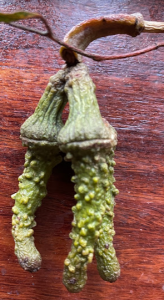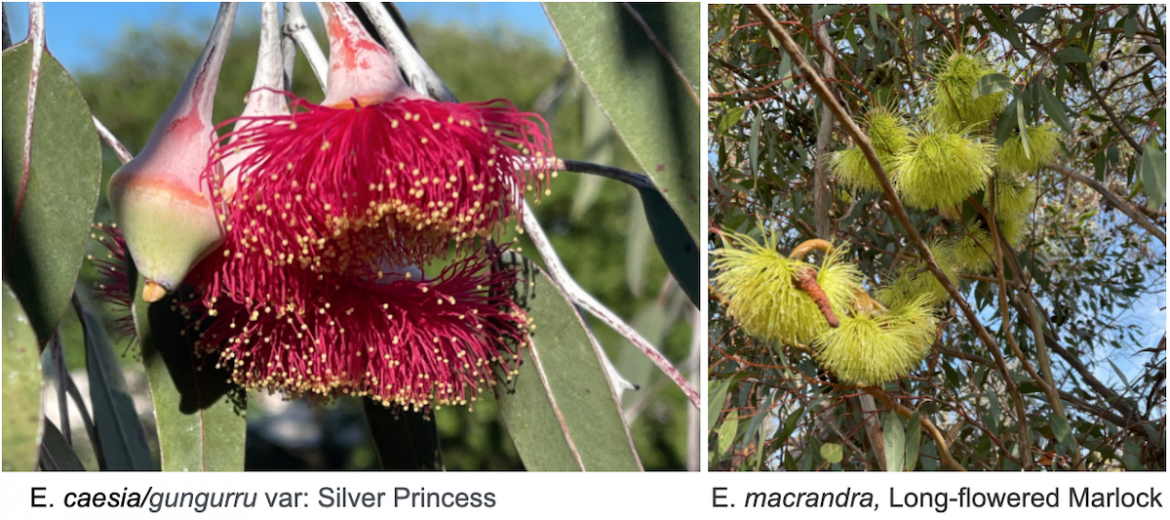post and photos by Rodney Marsh,
Pentecost and Trinity Sundays mark the beginning of winter where I live and, like Christine, I photographed the above flowers on Pentecost weekend. These flowers are two of many local flowering plants, like many types of wattles, that begin to flower March to May, when the rainy season starts. Their flowering season will last through to December. This Pentecost it was the eucalypts that spoke to me.The flowers above (E. caesia & E. macrandra) form on small trees (2-3 metres, 6-9ft).

This Silver Princess is in our front garden and it flowers most of the year. The photo at the top of the page shows one bud of the Silver Princess yet to shed it’s cap to reveal the beautiful red flower. The cap looks rather plain beside the flowers that have shed their caps to reveal their brilliant red stamens. Many varieties of honey eating birds love these flowers. The adjacent photo shows the beautiful nuts that hang on the branches all year, whilst other branches are flowering.

The right hand photo at the top of the page shows a flowering moort (E. macrandra). The photo was taken in local bush and shows one of the buds yet to shed its ‘long fingered’ cap to reveal its yellow stamens. The adjacent photo shows the buds of the flowering moort before flowering. They may look nondescript but remove the cap and the brilliant lemon flower will burst forth. These buds were removed by one of the many parrots who feed on the seeds within the large nuts.
These flowers tell me that despite what Gerard Manly Hopkins calls the ‘crushing’, utilitarian exploitation of nature, he says, “nature is never spent; there lives the dearest freshness deep down things”. Wherever we live in the world, flowers and all things, shine forth, giving praise and glory to God by their beauty. Observing nature, and all created things, is a spiritual practice, and it requires attention to these ‘deep down things’. This means we must remove our attention from our thoughts and feelings and direct our senses to the ‘other’ where God is found.
The word ‘eucalyptus’ means ‘beautiful cap/hat’ and refers to a unique characteristic that all trees in the genus Eucalyptus share – the presence of the ‘flower cap/hat’. Look again at the hats on the buds of E. caesia and E. macrandra on the topmost photos. When the ‘hat’ or ‘cap’ of the flower falls off, the beautiful stamens are revealed. In the season of Pentecost the shedding of these hats became for me, a metaphor for the gift of the Spirit. So, on the day of Pentecost, when the ‘cover’ of the Spirit was removed, the beauty and power of the Spirit burst forth. In secret, the flower of the Spirit was forming when Jesus was with his friends, then the cap was removed and the ‘the grandeur of God’ flamed out ‘like shining from shook foil’ (Hopkins). At last the ‘freshness of deep down things’ became visible, if you have eyes.
The flower colour and size of the genus Eucalyptus is enormous and the trees range from small shrubs to the tallest flowering plants in the world (the world’s tallest trees, Redwoods, are conifers). There are over 900 Eucalyptus species in Australia and that number is still growing. Nearby where I live, a botanical survey on the Ravensthorpe Ranges discovered ten new species of eucalypts. It seems astounding that these plants remained unknown to Science until 2019! This diversity of trees within the genus Eucalyptus reminded me of the great range of Pentecostal gifts given by the Spirit. The Pentecostal Spirit brings an infinite (yes ‘infinite’ in the real meaning of the word) palette of beauty within each human and between humans. Oh that we could really see.
Observe also how alike and different the flowers of E. caesia and E. macrandra are. Alike and different, as are all our friends, neighbours and enemies. Oh so different. Oh so alike. Alike because all life comes from one God and and different because all manifestations of God’s life is a unique manifestation of the life of the one God. Oh that we could see with the Spirit and uncover the beauty of all that is human and discover each individual’s unique beauty. Oh that we could see the as yet unseen and unrealised beauty within and without us. The way to discover the new and beautiful of the Spirit, within and without us, is to pay attention to what is.
This vision of beauty is both a miracle shown to us, and a miracle performed within us. The summer flowers of the Northern lands and the winter flowers of the Southern lands, both shine forth to us and in them we see a vision of God’s grace in all things. By the gift of Jesus’ Spirit within us are we able to see the world (and our neighbour) in this way. When the Spirit is given we begin to see Christ in all things and all things in Christ. When the Spirit comes all things become new (“if anyone is in Christ, there is a new creation: everything old has passed away; see, everything has become new ” 2 Cor 5:17 NRSV). Both the gift of sight and what is seen, are precious God’s gifts of love. These gifts enable our joyful participation in the life and love of God.
It is the gracious gift of God’s Spirit that makes observing flowers, birds, walking in nature and gardening spiritual practices. The Spirit opens our hearts to both see and dwell in the presence of God’s love in nature. Nature can only mediate God’s presence in this way because all created things share in God’s gift of life and we, too, can only see this beauty because we, too, share in God’s gift of life. To directly experience God’s beauty we need to pay attention (as my Primary School Science text title advised “Stop, Look and Listen”) to what is, then the beauty of what is will shine forth. If we are inattentive we will ‘have eyes but will not see and ears but will not hear.’
Spiritual Practise:
Thomas Merton (Journals, May 1965) writes of the novices he mentored, “…many of them are concerned with questions. Questions of liturgy… psychology… history. Are they the right questions? In the woods the whole world is naked and directly present, with no monastery (world) to veil it” (Journals May 1965 V241-42 From A Year With Thomas Merton: Daily Meditations from His Journals). The woods, like God, will often remain silent when we ask the questions which concern us, but, when we are still and silent and attentive to nature (the Kentucky woods, in Merton’s case) then the wordless healing of the Word becomes directly present to us, the importance of the questions we bring will fade and other questions will be asked of us.
Be quiet and still in the presence of a flower (or nature). Pay attention to the flower. Don’t analyse the flower, just be with it. Time yourself (2 mins? 5 mins? 10 mins? 60 mins? you choose) and be disciplined. If you are nowhere near a ‘nature place’ and cannot be with nature, you can still be still and present wherever you are and you can pay attention to what is. You are there, so God is there. You can choose to attend to your breath or any part of your body. Do not give your attention to your thoughts or feelings for these are your creations, not God’s creation. Remove your ‘cap’ and find your own special place in God’s beautiful world.
Embark on this healing journey with Christine Sine, Lilly Lewin, and Bethany Dearborn Hiser with the Time to Heal Online Course. Each session is lead by one of our instructors and allows you 180 days of access for only $39.99. The goal of this course is to provide time, space, and tools to work toward healing.


